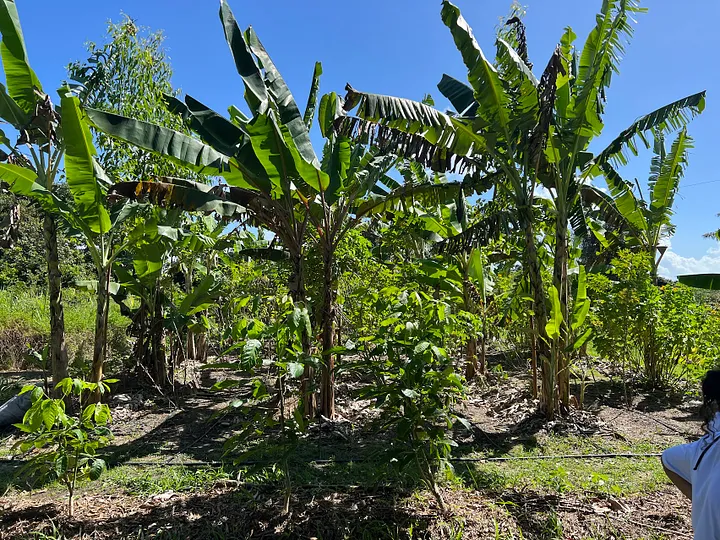This article will describe why we are financing agroforest systems and why this significantly increases the amount of CO2 being absorbed. Carbify Agroforestry
Part 1: Carbify agroforestry system benefits
Part 2: Tokenizing land and trees to fund agroforestry systems
Part 3: Advantages for wealthy Western investors to invest in the Amazon Rainforest.
Agroforestry, a farming practice incorporating native vegetation, fruit trees, crops, and occasionally livestock, has extensively documented ecological and agricultural advantages. These include increased diversity of birds and pollinators, enhanced soil quality, higher crop yields, and a cooling effect on the surrounding air. The systems also reduce storm damage. The systems are more ‘climate resilient. This cooling effect serves as a defence against global warming and provides a more comfortable environment for the farmers and residents. For Carbify, the absorption rates of CO2 are also crucial, as they play a vital role in generating a return on investment (ROI) for Western investors. Carbify Agroforestry
The CO2 absorption rates in Carbify are remarkably high compared to monoculture or other conventional planting methods. As we plant multiple trees, plants, bushes and ground cover the total amount of CO2 ‘per tree’ is much higher compared to regular calculations.
DEGRADED LAND
By using the agroforestry system techniques, degraded land can be converted to rich soil full of nutrients while absorbing massive amounts of carbon.
Deforestation in the Amazon rainforest has led to significant land degradation. Here’s an explanation of the process:
- Loss of Vegetation: Deforestation involves the removal of trees and vegetation from an area. As trees are cut down and cleared, the dense forest canopy opens up, leading to the loss of the intricate and diverse ecosystem in the rainforest.
- Soil Erosion: The dense vegetation in the Amazon rainforest plays a crucial role in preventing soil erosion. The roots of trees and plants hold the soil together, preventing it from being washed away by rainfall. When trees are removed, the exposed soil becomes vulnerable to erosion by wind and water, leading to the loss of fertile topsoil. Carbify Agroforestry
- Nutrient Depletion: The rich and fertile soils of the Amazon rainforest owe their fertility to recycling nutrients within the ecosystem. When trees are cleared, the nutrient cycle is disrupted. The removed vegetation is often burned, causing essential nutrients stored in the vegetation to be released into the atmosphere instead of recycled back into the soil. Over time, this depletion of nutrients makes the soil less fertile and less suitable for sustaining healthy plant growth.
- Increased Vulnerability to Drought: The intact Amazon rainforest acts as a natural reservoir, holding significant amounts of moisture and releasing it gradually. Deforestation disrupts this natural water cycle, leading to decreased rainfall and increased vulnerability to drought. As a result, the cleared areas become more prone to dryness, making it difficult for plants to survive.
- Biodiversity Loss: The Amazon rainforest is renowned for its extraordinary biodiversity, housing countless species of plants, animals, and microorganisms. Deforestation fragments and destroys habitats, leading to the loss of numerous species and disrupting delicate ecological balances.
The cumulative effects of deforestation in the Amazon rainforest result in significant land degradation, with far-reaching consequences for ecosystems, climate, and the livelihoods of local communities.
Carbify funds reforestation projects that utilize agroforestry techniques to transform degraded land into fertile soil and thriving forest systems.
 Degraded and deforested land will be used for Carbify reforestation projects shortly
Degraded and deforested land will be used for Carbify reforestation projects shortly
BARRIERS
Switching to agroforestry can be daunting for traditional small-scale farmers who have long depended on industrialized agricultural practices. The foremost obstacles inhibiting farmers from embracing agroforestry are the absence of governmental and community backing and insufficient financial aid. This is where Carbify comes in. We are working with partners able to offer community and governmental support while Carbify provides the funding. This is LIFE-CHANGING for these small farmers as they can fully depend on the harvest (food security) while being educated by our team and partners (social impact). The environment will be climate resilient and offer a haven for animals and birds, increasing the social impact even more.
AGROFORESTRY EXAMPLES
These systems can contain over 50 species of trees and plants. While plants and trees are growing, multiple species can be trimmed or cut down and used as fertilizer for ground coverage. Some bushes can be used as shade for tree saplings.

Most systems use trees providing wood like the Swietenia macrophylla (mahogany), cedar, mango, Simarouba and Bactris gasipaes. These trees need:
- Water: Water is provided by irrigation for 1 year until the banana trees are fully grown. Banana trees are great for keeping water into the system.
- Fruits: Farmers can provide food security for whole villages by planting fruit in between the trees like acai, banana, cocos, papaya and passion fruit.
- Detoxify: Plants like the Mexican sunflower can suck poisonous stuff from the soil. They will naturally clean the soil.
- Fertilizer: We can use the fruit trees/plants as fertilizer after a few months or after a cycle.
- Shade: Plants and fruit trees can provide shade for other trees in the system. Strategically placing these shade providers is essential.
We plant coffee, cacao, papaya, and others in the system to provide food security.
Farmers are still experiencing different species to increase their effectiveness. Agroforest systems are superior to any other system in many ways!

ABOUT CARBIFY
Carbify offers money and support for local (poor) farmers in the Amazon biome. We aim to reforest the Amazon rainforest and provide food security, financial security, and high social impact for the underprivileged using the agroforest systems. We tokenized trees and land to raise money. Investors will earn CO2 tokens, which they can sell for a profit. Both the investors and the farmers benefit from this!
While doing so, we regenerate the Amazon rainforest while creating happy people and more wealthy investors. A real win-win-win for everyone involved.
Want to learn more?
Carbify Website: https://www.carbify.io
Press: info@carbify.io

























